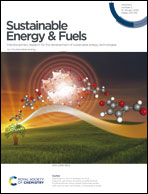Selective conversion of hydroxymethylfurfural to diformylfuran using copper hydroxide nitrate with various nano-structures: a comparative study†
Abstract
As Cu combined with 2,2,6,6-tetramethylpiperidin-oxyl (TEMPO) represents a promising catalyst for oxidizing 5-hydroxymethylfurfural (HMF) to 2,5-diformylfuran (DFF), and the nitro-group would promote the catalytic activity of TEMPO, the Cu and nitro-containing material, copper hydroxide nitrate hydroxide (CHN), appears to be a promising heterogeneous catalyst for HMF oxidation. Since catalytic activities of solid materials are strongly related to their morphologies, and structures, herein, the present study aims for the first time to explore the catalytic activities of CHNs with various shapes for HMF oxidation to DFF. Specifically, CHNs with different morphologies are fabricated to exhibit bar-like, strip-like, and even flower-like shapes through a very convenient one-step solvothermal process. While these CHNs consisted of very similar compositions, their textural properties were distinct as the CHN-flower can exhibit more superior textural properties and more acid sites/mobile oxygen, followed by the CHN-strip, and then the CHN-bar. As these CHNs and TEMPO were individually adopted, almost no HMF could be successfully converted to DFF. Nevertheless, the combination of CHNs and TEMPO leads to almost complete conversion of HMF with significantly high selectivities (>95%). In particular, the CHN-flower could even achieve SDFF = 99%, which was much higher than reported values using various catalysts. The CHN-flower was also validated to enable much faster HMF conversion at 100 °C. These results demonstrate that CHNs are certainly useful catalysts for HMF conversion, and the morphology of CHNs could be manipulated to enhance their catalytic activities.



 Please wait while we load your content...
Please wait while we load your content...